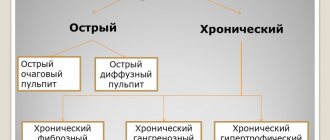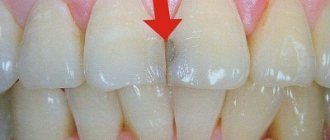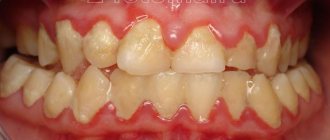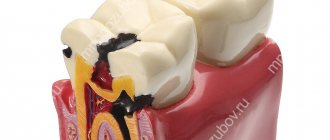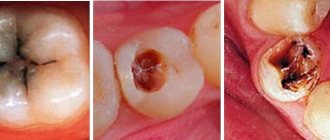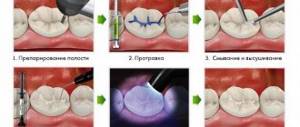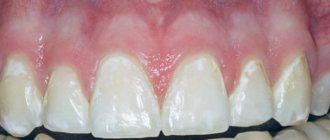Caries and pulpitis are two common dental diseases that have similar symptoms. Moreover, the second disease can act as a complication of the first. However, the treatment methods for these pathologies are slightly different. In this article we will tell you how to distinguish caries from pulpitis. Can I do this myself?
In this article
- How to distinguish deep caries from pulpitis
- Diagnosis of caries and pulpitis
- How to treat deep caries and pulpitis
- Prevention of caries and pulpitis
To understand the differences between caries and pulpitis, you should consider the features of both pathologies. Carious lesion is a slowly developing process of destruction of hard tooth tissues, resulting from the proliferation of cariogenic microbes. Bacteria produce acids that corrode enamel and dentin. This process develops slowly, but is constantly progressing.
Pulpitis is an inflammatory disease of the pulp - the soft tissue located inside the tooth. As a rule, it occurs due to infection of the pulp by bacteria, which spread as caries progresses. If a carious lesion is left untreated, it penetrates into the dentin and affects the soft tissue.
Pulpitis can develop for other reasons, for example, after mechanical trauma and chipping of part of the tooth. But in most cases it is diagnosed in people with advanced caries. The etiology and mechanism of development of these pathologies have similar features. They also have common symptoms, so pulpitis and caries are often confused. Let us describe the signs of both pathologies.
Why does inflammation develop?
The main reason for the development of inflammatory processes in the pulp is infection due to advanced caries. Usually (in 90% of cases) the infection enters the pulp through a carious cavity. But sometimes a retrograde route is possible (the penetration of bacteria through a hole in the root or periodontal pockets). It is extremely rare (with osteomyelitis, acute respiratory infections, rubella, chickenpox, sinusitis) the infection is introduced through the blood - the hematogenous route.
Other factors can cause pulpitis:
- poor-quality treatment of a carious cavity or accidental damage to the pulp chamber during the treatment of caries;
- improper filling of the canal;
- pulp burn when grinding a dental crown before prosthetics;
- gum diseases leading to the formation of periodontal pockets;
- tooth injury.
Depending on the etiology, there are 4 types of pulpitis:
- infectious
– develops due to the penetration of pathogenic bacteria into the pulp;
- traumatic
– the cause is a violation of the sterility of the pulp due to traumatic damage to the tooth, due to which opportunistic bacteria are directed into the pulp chamber and provoke inflammation;
- iatrogenic, or medical
– occurs due to the fault of the dentist due to improper treatment of the carious cavity;
- calculiform
– the result of a metabolic disorder in the neurovascular bundle, accompanied by the formation of stones or denticles (replacement dentin).
Differences in treatment
Approaches to the treatment of caries and pulpitis have several common features, but differ in nuances. Therefore, before starting therapy, a diagnosis is carried out, based on the results of which the type of disease is determined.
How to recognize and properly treat deep caries in time
Treatment of caries is carried out according to the following scenario:
- Removal of tooth tissue affected by caries.
- Grinding the walls and bottom of the drilled cavity to eliminate all pathogens.
- Placement of an antibacterial substance into the prepared cavity.
- Installation of a special gasket.
- Installation of a light-polymer or other filling.
- Grinding the filling.
After filling the affected tooth, pain may continue to bother the patient for some time. If there is serious damage, in addition to removing tissue affected by the carious process, the following is installed:
- adhesive materials;
- prostheses;
- crowns
Caries treatment is carried out during one session at the dentist. Eliminating pulpitis will take more time. Therapy for the disease involves the restoration of upper tissues, so it is carried out according to a similar scenario as the treatment of caries:
- Removal of the top layer of the tooth. This must be done to gain free access to the affected pulp.
- Elimination of the source of inflammation.
- Filling a tooth or installing a prosthesis (adhesive materials, crown).
Let's find out whether it hurts to treat caries
Elimination of the source of inflammation is carried out according to two scenarios:
- With preservation of connective tissue. This operation is performed at the early stages of pulpitis and if there are appropriate indications. Therapy consists of the use of anti-inflammatory and antiseptic drugs.
- With removal of connective tissue. The operation is usually prescribed in advanced cases.
The first option is considered the most preferable treatment, as it allows you to preserve the nutrition of the tooth.
Regardless of the type of pathology, preventive measures in both cases will be the same. To prevent the development of the diseases in question, it is necessary:
- regularly follow the rules oral hygiene
- timely treatment of dental diseases;
- adhere to proper nutrition, reducing the amount of sweet and spicy foods;
- carry out actions to strengthen local and general immunity.
Signs of illness
Typically, pulpitis manifests itself as a pain syndrome, which can have varying severity.
Depending on the manifestations of the disease, pulpitis is distinguished:
- acute - accompanied by severe paroxysmal pain (they intensify at night), occurring both spontaneously and as a result of exposure to cold or heat, the pain often radiates to the neck, ears, temples and does not go away even when taking analgesics;
- chronic – the pain is aching, almost imperceptible, and appears quite rarely.
Acute pulpitis can be serous and purulent. If a purulent process develops, the pain becomes constant and acquires a shooting and pulsating character.
Preparing for the appointment:
- do not drink alcohol the day before your appointment, as alcohol weakens the effect of anesthesia;
- do not smoke before your appointment;
- try not to eat onions, garlic and other foods with a strong pungent odor;
- but you still need to eat; a well-fed person produces less saliva;
- warn your doctor about allergic reactions;
- Brush your teeth thoroughly and use an irrigator (a device for performing oral hygiene at home) if you have one.
How to distinguish pulpitis from other diseases?
Many dental diseases are accompanied by pain. But with pulpitis they differ in some characteristic features.
Pulpitis and caries
With caries, pain appears only when exposed to thermal or chemical irritants. If the irritant is eliminated, the pain syndrome immediately stops. With pulpitis, pain most often occurs for no reason. If it is caused by an irritant, then after its elimination the pain disappears no earlier than after a quarter of an hour.
Pulpitis and trigeminal neuralgia
Usually, with pulpitis, the severity of pain is much less than with neuralgia. But sometimes the severity of pain in these diseases is comparable. The difference is that with neuralgia the pain syndrome disappears or is greatly weakened at night, while with pulpitis it intensifies.
Pulpitis and periodontitis
With pulpitis, percussion and biting do not cause pain. With periodontitis, any of these actions causes severe pain.
X-rays will help distinguish between these diseases. With pulpitis, it will not show any pathologies, but with periodontitis, changes will be noticeable.
But you should not try to diagnose and treat pulpitis on your own, as this can cause various complications and lead to tooth loss. If you experience the slightest pain, you should contact a dental clinic.
Possible complications of the disease
Unfortunately, even with severe symptoms of pulpitis, not all people rush to seek professional dental care. Patients who are afraid of the upcoming treatment of pulpitis endure pain for a long time and try to drown it out by taking pills and using a variety of traditional medicine recipes. However, it is worth remembering once and for all: all these measures are useless and will not help get rid of pulpitis, but they can lead to the development of serious and dangerous complications.
Most often, postponing the treatment of pulpitis “for later” leads to the development of periodontitis, a disease that affects the tissues around the tooth root. Periodontitis can be either acute or chronic. With an acute form of the disease, it will no longer be possible to avoid visiting the dentist: the pain becomes so severe that it is impossible to touch the tooth, the pain does not subside for a minute and the person can neither eat nor speak. Against the background of acute periodontitis, body temperature may rise and swelling of the gums may appear. When the canals are opened, a large amount of purulent fluid comes out of them.
The chronic form of periodontitis is characterized by the formation of fistulas that appear on the gums. Formations appear due to the formation of canals extending from the dental root of the tooth.
From time to time, purulent fluid also leaks from the fistulas, and at this point the pain may subside. Cysts can also form against the background of periodontitis. Granulomas appear at the root of the tooth and look like sacs filled with purulent fluid. The process of treating a cyst is quite complex, and it cannot always be carried out using conservative therapy methods.
However, these are not all the consequences that advanced pulpitis can lead to. If untreated, the disease can cause complications that affect the entire human body. It is worth talking about these complications of pulpitis in more detail, because all of them are quite capable of manifesting themselves if the symptoms of pulpitis are ignored and attempts to cure it on their own. Most often, periostitis occurs against the background of inflammation in the pulp.
With periostitis, inflammation occurs that affects the periosteum of the jaw and is accompanied by the rapid spread of pus through the tissues. A person’s general health deteriorates, a high temperature appears, the shape of the face changes, and a strong feeling of pressure occurs near the diseased tooth. Treatment for this disease requires surgery and can be so painful that it is often performed under general anesthesia.
Osteomyelitis, which can also be a complication of advanced pulpitis, is a purulent process that has developed to such an extent that the pathological phenomenon of bone tissue dissolution is observed. The disease causes loosening not only of the diseased tooth, but also of the healthy “neighbors” located next to it.
It is important to know: Osteomyelitis is a dangerous disease fraught with very serious consequences. If it has developed to a certain stage, then tooth extraction is required, which is very difficult. Osteomyelitis causes thinning of bone tissue and when trying to remove a dental unit, there is a high risk of a jaw fracture or part of it breaking off along with the diseased tooth.
Abscess and phlegmon are inflammations of a purulent nature, differing in the degree of spread. Both conditions are extremely dangerous as they can be fatal. When diseases appear, the infection begins to actively spread in the intermuscular space and affects blood vessels and nerves.
Sepsis is a condition characterized by infection in the blood fluid and its contamination with toxic substances. Sepsis often leads to death because the infection spreads through the blood extremely quickly.
These may be the consequences of pulpitis, which are worth knowing about and taking into account their possibility every time, for some reason, you are going to postpone a visit to the doctor. Remember, pulpitis can only be cured in the dentist’s office and there is no need to be afraid of pain: modern anesthetics completely eliminate any discomfort for the patient during treatment.
Therapeutic methods
If tooth pulpitis is diagnosed, treatment can be carried out in two ways:
- surgical – tooth depulpation is performed;
- conservative - it is possible to preserve the pulp.
Surgery
This method is traditional and is used in most cases. But in this case, the tooth after pulpitis changes its color and becomes more fragile.
Depulpation (the so-called procedure for removing a nerve) can be performed either after preliminary killing of the nerve or without it.
Surgical treatment is carried out in several stages:
- an anesthetic is administered;
- remove the pulp and eliminate tissue damaged by caries;
- estimate the length of the channels;
- install a temporary filling;
- if no complications arise, then at the second visit they clean, expand, wash with antiseptic agents and seal the canals, having previously installed the pins;
- install a permanent filling on the dental crown.
The quality of the filling is controlled using x-rays.
Conservative treatment
Preserving the pulp is only possible in children and people under 30 years of age if they went to the dentist at the initial stage of the disease, which happens extremely rarely, since most people endure pain until the last moment. If purulent processes begin in the pulp, it will have to be removed.
The conservative method involves thorough treatment of the dental cavity with medications, after which a filling is installed.
Diagnosis of caries and pulpitis
Actually, there is no need to diagnose at home and try to find the differences between these diseases on your own. If you have a toothache, you need to go to the dentist, regardless of whether the cause is caries or pulpitis. The doctor will make a diagnosis based on an external examination of the tooth. He can also prescribe laboratory and instrumental diagnostic methods.
If a carious process is suspected, a special dye test is used. A pigment composition is applied to the enamel, which colors the carious lesion blue. If caries is not confirmed, the doctor will check the pulp for sensitivity. If necessary, radiography is prescribed. X-rays can reveal hidden carious cavities in the interdental spaces or under the gum.
FAQ
How much will the treatment cost?
The price of treatment depends on several factors. On average, when treating caries, you should focus on the cost from 5,700 to 8,500 rubles. The cost varies and depends on the location of the caries, that is, how many tooth walls are damaged by the carious process.
Is it possible not to put a crown, even if it is indicated?
A simple filling will not be able to protect the remains of the tooth from cracking. The teeth are subject to constant stress in the process of chewing food, so it will end either in tooth loss or a repeated visit to the dentist and additional expenses. Therefore, if a doctor recommends getting a crown, you should listen to him.
How long will the treatment take?
Many patients do not go for years, then come to see the dentist with a whole “bouquet” of oral diseases. Accordingly, treatment periods are different for everyone. If these are six to eight small carious cavities, not complicated by pulpitis or periodontitis, then, as a rule, two or even three teeth are done at one time. Then it turns out that the patient can be cured in three visits. If the amount of work is large, the process is delayed. Sometimes for a couple of weeks, and sometimes for several years, if there is a need for orthodontic treatment, implantation, etc. A treatment plan can be drawn up at the first consultation after the CT scan.
Are there any guarantees for treatment?
The warranty on fillings and crowns in our dentistry is two years.
PRICES FOR SERVICES
| Services | Price, rub.) |
| Consultation with a dentist. Dental status of the patient, drawing up a treatment plan | 500 |
| Repeated consultation with a dentist | 500 |
| Treatment of non-carious tooth damage | |
| Treatment of non-carious tooth damage (wedge-shaped defect/enamel erosion, chipped/defective filling) | 4 600 |
| Treatment of caries | |
| Treatment of average caries | 5 700 |
| Treatment of deep caries (one surface) | 5 800 |
| Treatment of deep caries (two surfaces) | 6 100 |
| Treatment of deep caries (three surfaces) | 6 500 |
| Tooth restoration | |
| Restoration of a tooth in the lateral group with destruction of more than 50% | 8 300 |
| Restoration of the central tooth with more than 50% destruction and direct veneering | 8 500 |
| Treatment of pulpitis/periodontitis ( anesthesia included in the price) | |
| Single-channel pulpitis | from 9 600 |
| Two-channel pulpitis | from 11 200 |
| Three-channel pulpitis | from 15 100 |
| Four-channel pulpitis | from 18 800 |
| Single-channel periodontitis | from 12 700 |
| Double-channel periodontitis | from 16 800 |
| Three-channel periodontitis | from 22 400 |
| Four-channel periodontitis | from 27 500 |
If you need a consultation with a dental therapist, come to Medical Dentistry.
Tooth pulpitis: symptoms
So, we now understand what dental pulpitis is, and we move on to the symptoms of this disease. With pulpitis, different severity of symptoms can be observed - from acute paroxysmal pain to minor pain. In this regard, there are 2 of its forms: acute and chronic.
- Acute form of pulpitis – signs of pulpitis in this case are reduced to the appearance of acute paroxysmal pain (especially at night). The pain is spontaneous and occurs spontaneously without any irritants. However, during “pain-free intervals” pain can be provoked by thermal irritants, mainly cold water, although it is also possible from hot water.
An important point: after eliminating the irritant, the pain does not go away for about 10-15 minutes. The latter circumstance makes it possible to distinguish pulpal pain from pain due to deep caries, because with the latter, the cessation of pain occurs immediately after the cessation of the stimulus.Often patients cannot correctly identify the diseased tooth, because pain can radiate along the nerves to the entire jaw. The severity of the pain increases as the inflammation transitions from serous to purulent. As the purulent process develops, the pain becomes pulsating, shooting, tearing, and the pain-free intervals shorten until they disappear completely (24stoma.ru).
- Chronic form of pulpitis - pain in this form of pulpitis is usually aching, not expressed, and is of a rare periodic nature. Very rarely, pain may be completely absent. Periodically, chronic inflammation can turn into acute, with the appearance of corresponding acute symptoms.
Important: what form of pulpitis will occur depends solely on the virulence (level of pathogenicity) of microorganisms, as well as on the characteristics of the body’s immune response to infection. With increasing age, the frequency of acute forms of pulpitis decreases - due to a decrease in the capabilities of the body's immune response.
